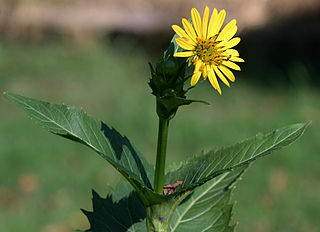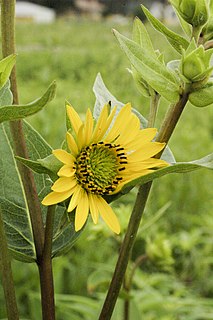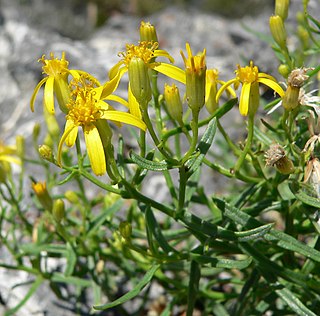
Silphium is a genus of North American plants in the tribe Heliantheae within the family Asteraceae.

Silphium laciniatum is a species of flowering plant in the family Asteraceae known commonly as compassplant or compass plant. It is native to North America, where it occurs in Ontario in Canada and the eastern and central United States as far west as New Mexico. Other common names include prairie compass plant, pilotweed, polarplant, gum weed, cut-leaf silphium, and turpentine plant. It is a rosinweed of genus Silphium.

Lapsana communis, the common nipplewort, is a species of flowering plant in the family Asteraceae. It is native to Europe and southwestern Asia. and widely naturalized in other regions including North America.

Elodea canadensis is a perennial aquatic plant, or submergent macrophyte, native to most of North America. It has been introduced widely to regions outside its native range and was first recorded from the British Isles in about 1836.

Lactuca canadensis is a species of wild lettuce known by the common names Canada lettuce, Canada wild lettuce, tall lettuce, and Florida blue lettuce. Its true native range is not clear, but it is considered to be a native of the eastern and central parts of North America. It naturalized in the western part of the continent as well as in Eurasia.

Silphium asteriscus, commonly called starry rosinweed, is an herbaceous plant in the family Asteraceae. It is native to the eastern United States, from Oklahoma and Texas east to Florida and Pennsylvania. It is a widespread species found in a variety of open habitats, such as prairies and woodlands.

Silphium perfoliatum, the cup plant or cup-plant, is a species of flowering plant in the family Asteraceae, native to eastern and central North America. It is an erect herbaceous perennial with triangular toothed leaves, and daisy-like yellow composite flower heads in summer.

Silphium integrifolium is a species of flowering plant in the family Asteraceae. Its common names include rosinweed, whole-leaf rosinweed, entire-leaf rosinweed, prairie rosinweed, and silflower. It is native to eastern North America, including Ontario in Canada and the eastern and central United States as far west as New Mexico.

Myriophyllum verticillatum, the whorl-leaf watermilfoil or whorled water-milfoil, is a native to much of North America, North Africa, and Eurasia. It closely resembles another native milfoil, called northern water milfoil Whorled water milfoil is also easily confused with four types of invasive milfoils: Eurasian water milfoil, Variable water-milfoil, Parrot feather, and hybrid water milfoil.
Stuckenia striata is a species of aquatic plant known by the common names broadleaf pondweedNevada pondweed and striped pondweed. It is native to the Americas, including the southwestern United States, northern Mexico, and parts of Central and South America. It grows in waterways such as rivers, canals, and shallow ponds, often in alkaline water. This is a perennial herb producing a long, thin, branching stem approaching 2 m in maximum length. The narrow, hairlike leaves are up to 10 cm (3.9 in) long and only a few millimeters wide. The inflorescence is a spike of flowers arranged in whorls and borne on a short peduncle.

Senecio spartioides is a species of flowering plant in the aster family known by the common name broom-like ragwort. It is native to the western United States as far east as the Dakotas and Texas, and northern Mexico. It can be found in dry, rocky, often disturbed areas in a number of habitat types. It is a subshrub which can exceed a meter in height, its arching stems growing from a woody-topped taproot. The leaves are linear in shape and up to 10 centimeters long. The leaves usually have smooth, unlobed edges, but slightly lobed leaves are seen at times. The leaves are evenly distributed along the stems, the ones low on the stems withering away early, giving the plant a naked appearance on the lower half while the top is still lush green and blooming. The inflorescences are spreading, flat-topped arrays of many cylindrical flower heads. The heads contain yellow disc florets and generally either 5 or 8 ray florets each about a centimeter long.

Lilium iridollae is a species of Lilium or lily. It is a perennial forb. This species is considered one of five known Lilium species native to specific sites in the United States' southeast region. In 1940, this species was discovered by Mary Henry in its habitat. She named the lily in reference to a "pot of gold at the end of the rainbow".

Blephilia hirsuta is an herbaceous perennial of the mint family Lamiaceae native to eastern North America. It is commonly called hairy wood-mint or hairy pagoda plant.

Cyclachaena xanthiifolia, known as giant sumpweed, or rag sumpweed is a North American plant species in the sunflower family, Asteraceae. It is the only species in the genus Cyclachaena. Giant sumpweed is believed to be native to the Great Plains but is now found across much of southern Canada and the contiguous United States, though rarely in the Southeast.

Silphium albiflorum, commonly known as white rosinweed, is a species of flowering plant in the family Asteraceae. It is native to the United States, where it is endemic to the state of Texas. Its natural habitat is in open, calcareous prairies.

Silphium radula, commonly known as roughstem rosinweed, is a species of flowering plant in the family Asteraceae. It is native North America, where it is found in the South Central region of the United States. Its natural habitat is prairies over sandy or calcareous soil.

Hypericum suffruticosum, known as pineland St. John's-wort, is a species of flowering plant in the St. John's wort family, Hypericaceae. It is native to the Southeastern United States.
Silphium wasiotense, commonly called Appalachian rosinweed, is a species of flowering plant in the family Asteraceae. It is native eastern to North America, where it is endemic to the Cumberland Plateau of Kentucky and Tennessee. Its natural habitat is in dry open woodlands. It is considered rare throughout its range.

Thaspium trifoliatum, commonly called meadow-parsnip, is a species of flowering plant in the carrot family (Apiaceae). It is native to eastern North America where it is found in many eastern U.S states and in Ontario, Canada. It has a broad natural habitat, which includes mesic to dry forests and woodlands, prairies, bluffs, and rock outcrops.
Silphium perplexum is a prairie species in the family Asteraceae, it is endemic to the state of Alabama. S. perplexum is commonly known as Old Cahaba rosinweed, a reference to the Cahaba River near which all populations of this species are found.

















